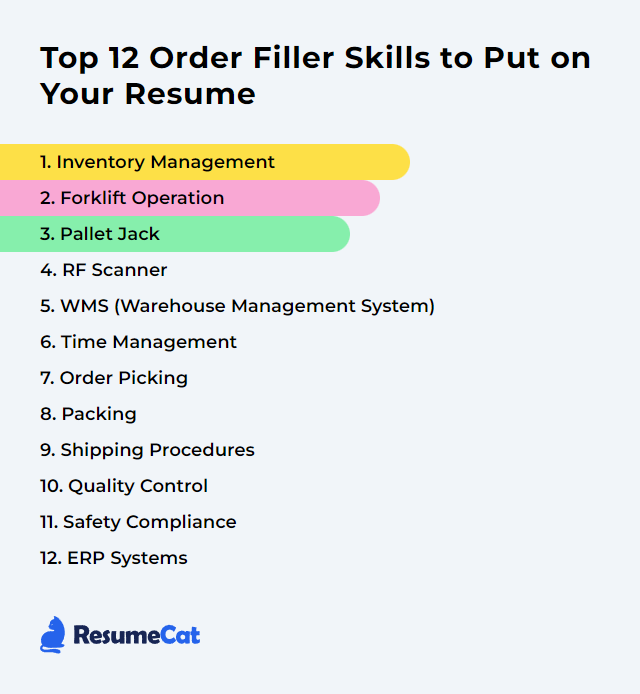Top 12 Order Filler Skills to Put on Your Resume
Standing out as an order filler isn’t about muscle alone. It’s precision, rhythm, smart systems, and a steady hand under pressure. Build the right mix of skills, make them visible on your resume, and you’ll move to the front of the line—fast.
Order Filler Skills
- Inventory Management
- Forklift Operation
- Pallet Jack
- RF Scanner
- WMS (Warehouse Management System)
- Time Management
- Order Picking
- Packing
- Shipping Procedures
- Quality Control
- Safety Compliance
- ERP Systems
1. Inventory Management
Inventory management means knowing what’s on hand, where it lives, and when it moves. Accurate counts make orders flow. Bad data? Delays, stockouts, and costly do-overs.
Why It's Important
It keeps the right products available at the right moment. That shrinks picking time, cuts errors, and keeps customers happy.
How to Improve Inventory Management Skills
- Use a single source of truth: Record receipts, moves, and picks in real time. No side spreadsheets. No guesswork.
- Cycle count routinely: Small, frequent counts beat big, rare ones. Catch drift early.
- Forecast with facts: Lean on sales history, seasonality, and promotions to set reorder points that actually hold.
- FIFO everywhere: Slot stock so older units flow first. Less waste, fewer write-offs.
- Lean stocking: Right-size safety stock by SKU velocity and supplier reliability. Keep space for what moves.
- Supplier alignment: Agree on lead times, pack quantities, and labeling. Fewer surprises at receiving.
- Train for accuracy: Scanning discipline, location confirmations, and putaway rules—drilled until second nature.
- Alerts and audits: Low-stock warnings, exception reports, and routine variance reviews to course-correct fast.
How to Display Inventory Management Skills on Your Resume
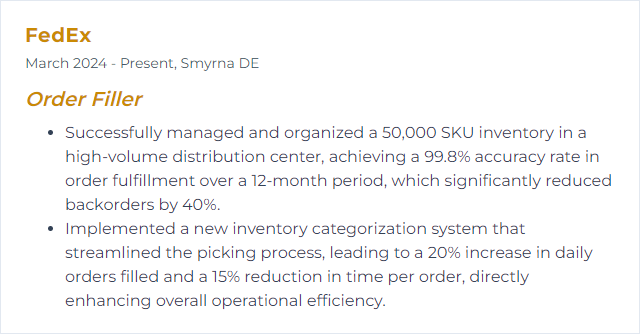
2. Forklift Operation
Operating a forklift means moving heavy product safely and quickly without drama. Tight turns, clean lifts, zero damage.
Why It's Important
Big loads don’t move themselves. Safe, competent operation accelerates picks and replenishments and prevents costly incidents.
How to Improve Forklift Operation Skills
- Get trained and refreshed: Formal instruction, hands-on practice, and periodic re-evaluation keep skills sharp and compliant.
- Inspect before use: Brakes, forks, mast, horn, tires, battery or fuel—checklists save headaches.
- Load control: Know capacity, center the weight, tilt back, low travel height. Stability over speed.
- Clear lanes and sightlines: Mirrors, spotters, and marked pathways reduce blind spots and near-misses.
- Maintain the fleet: Scheduled service prevents breakdowns during peak hours.
How to Display Forklift Operation Skills on Your Resume
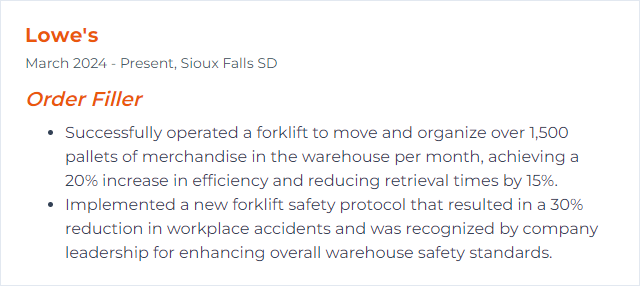
3. Pallet Jack
A pallet jack—manual or powered—lets you snake pallets through aisles, into staging, and onto trucks without lifting a sweat.
Why It's Important
It’s the everyday workhorse. Quick moves, less strain, more throughput.
How to Improve Pallet Jack Skills
- Ergonomics matter: Handle height, stance, and two-hand control reduce fatigue on long shifts.
- Keep it rolling: Lubricate, replace worn wheels, and fix leaks early so it glides instead of fights you.
- Smart routing: Plan paths that skip congestion and sharp turns with heavy loads.
- Right wheels, right floor: Poly for smooth concrete, softer compounds for quieter runs or rougher surfaces.
- Know the limits: Respect load capacity and secure skids before moving.
How to Display Pallet Jack Skills on Your Resume
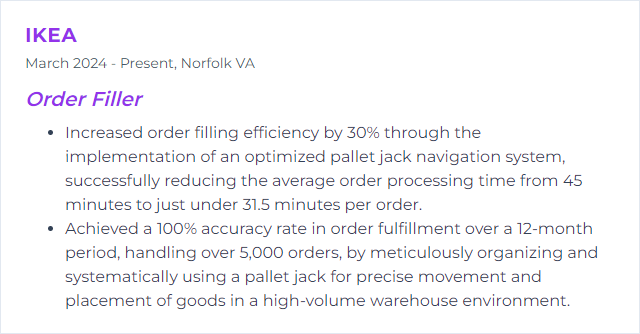
4. RF Scanner
RF scanners read barcodes, confirm locations, and sync picks to the system in real time. No paper, no lag.
Why It's Important
They slash errors and speed up every move from receiving to ship. Data you can trust, right now.
How to Improve RF Scanner Skills
- Ergonomic setups: Comfortable grips, wrist straps, or wearables for all-day scanning without strain.
- Battery discipline: Hot-swap spares, charging racks, and usage schedules to avoid dead devices mid-pick.
- Fast connectivity: Strong warehouse Wi‑Fi with roaming tuned for aisles and racking.
- Clean screen flows: Short prompts, big buttons, and minimal taps reduce pick time.
- Scan accuracy: Train on aim, distance, and re-scan rules to stomp out misreads.
- Preventive care: Cases, screen protectors, and routine cleaning of lenses keep performance crisp.
How to Display RF Scanner Skills on Your Resume
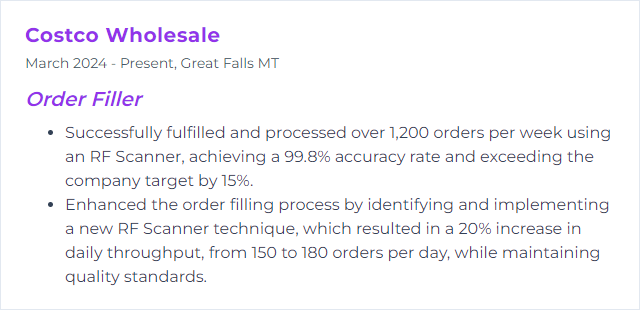
5. WMS (Warehouse Management System)
A WMS guides the flow—receipts, putaway, picks, packs, and ship. It’s the traffic controller for the floor.
Why It's Important
With accurate tasks and locations, order fillers move faster and make fewer mistakes. The whole building hums.
How to Improve WMS (Warehouse Management System) Skills
- Optimize pick paths: Slot fast movers up front and tune routes to cut travel miles.
- Real-time visibility: Use live dashboards for waves, backlog, and exceptions so issues don’t snowball.
- Mobile-first workflows: Simple, step-by-step screens for receiving, picking, and packing reduce training time.
- Automation hooks: Integrate with conveyors, print-and-apply, or robotics where volume justifies it.
- Data hygiene: Clean item masters, units of measure, and locations—bad data breaks good systems.
- Continuous feedback: Capture operator input and iterate screens and rules quickly.
How to Display WMS (Warehouse Management System) Skills on Your Resume
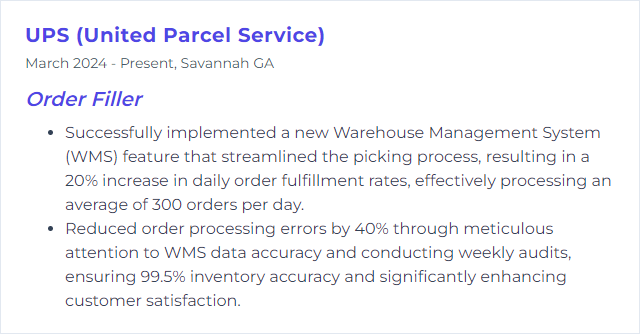
6. Time Management
It’s the art of sequencing tasks so nothing jams. You hit cutoffs, clear waves, and leave no order behind.
Why It's Important
Deadlines are real. Carriers don’t wait. Good time habits keep service levels intact and overtime down.
How to Improve Time Management Skills
- Prioritize by cutoff: Pull orders aligned to carrier times and service level first.
- Batch and wave: Group similar SKUs, zones, or customers to reduce travel and touches.
- Limit context switching: Finish one pick path before starting the next. Fewer stops and starts.
- Use slotting to your advantage: Put high-velocity items within quick reach of packing.
- Timebox tricky tasks: Set short, focused windows for problem orders and returns.
How to Display Time Management Skills on Your Resume
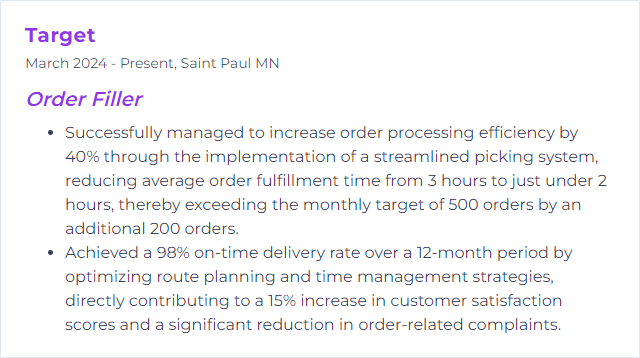
7. Order Picking
Select items accurately, fast, and with the least walking possible. That’s the game.
Why It's Important
Picking is the heartbeat of fulfillment. Accuracy and speed here determine everything downstream.
How to Improve Order Picking Skills
- Choose the right method: Zone, batch, wave, or cluster picking—match the approach to volume and mix.
- Guided tech: Voice, pick-to-light, and smart scanning cut search time and mispicks.
- Slot by velocity: Golden zone for top SKUs, clear labels, and tidy bins to reduce hunt time.
- Standard work: Defined paths, scan-confirm rules, and verification steps keep quality tight.
- Kaizen mindset: Review misses weekly and fix root causes, not just symptoms.
How to Display Order Picking Skills on Your Resume
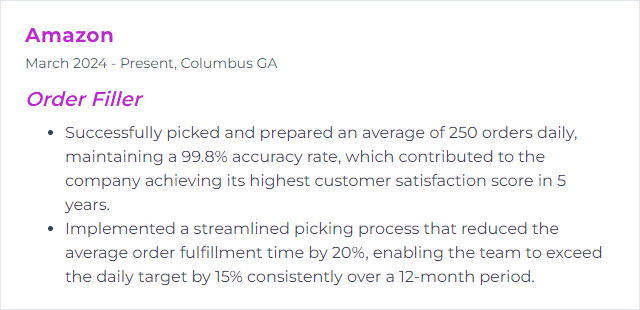
8. Packing
Box it right, secure it tight, and protect it from the bumps between dock and door.
Why It's Important
Good packing prevents damage, trims shipping costs, and leaves customers with a clean unboxing experience.
How to Improve Packing Skills
- Right-size packaging: Match box to contents to reduce void fill and dimensional weight.
- Standard stations: Organized benches with cutters, tape, dunnage, and printers within reach.
- Fragile rules: Corner protection, wrap layering, and drop tests for high-risk items.
- Print-on-demand labels: Labels generated at pack-out eliminate relabel errors.
- Quality checks: Verify SKU, quantity, and condition before sealing—scan to confirm.
How to Display Packing Skills on Your Resume
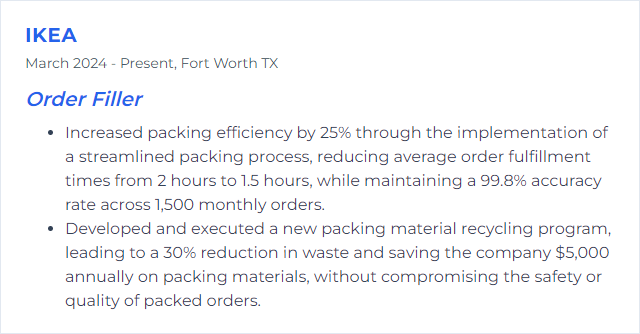
9. Shipping Procedures
From picked to packed to out the door—clean handoffs, correct labels, and on-time carrier scans.
- Picking: Pull the right items, confirm with scans.
- Packing: Protect the goods and apply the correct documentation.
- Labeling: Accurate ship-to, service level, and hazmat (if applicable).
- Dispatching: Stage by carrier and cutoff, then load and confirm pickup scans.
Why It's Important
Tight procedures prevent misroutes, chargebacks, and late deliveries. That protects margins and trust.
How to Improve Shipping Procedures Skills
- Standardize cartons and dunnage: Fewer choices, faster packing, consistent protection.
- Automate labels: Rate shop and print labels from order data to reduce manual entry.
- Stage smart: Separate by carrier, service, and destination to avoid cross-loading.
- Know cutoffs: Align waves to pickup windows so nothing misses the truck.
- Measure and refine: Track ship accuracy, damages, and on-time rates; fix recurring blockers.
How to Display Shipping Procedures Skills on Your Resume
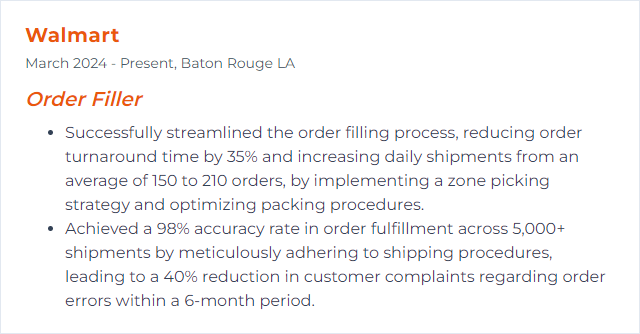
10. Quality Control
QC is the gatekeeper. It verifies the right item, right count, right condition before anything leaves the building.
Why It's Important
Catch errors upstream and returns plummet. Happy customers, fewer refunds, cleaner metrics.
How to Improve Quality Control Skills
- Standard inspection points: At pick, at pack, and before ship—quick checks that matter.
- Sampling plans: Risk-based spot checks for high-volume or high-value orders.
- Scan verification: Barcode-to-order confirmation beats eyeballing every time.
- Defect tagging: Record issues by type and source, then fix the process that caused them.
- Clear visuals: Photos, guides, and examples of acceptable packaging and labeling.
How to Display Quality Control Skills on Your Resume
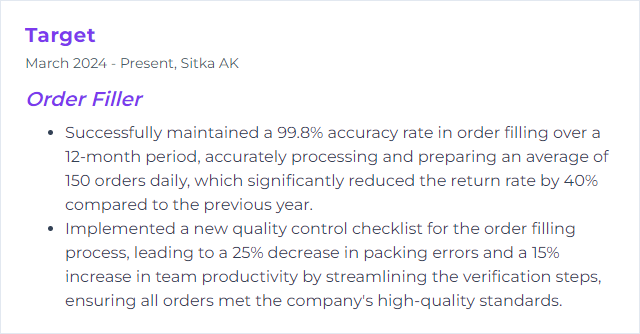
11. Safety Compliance
Safety isn’t paperwork. It’s habits, layouts, and checks that prevent injuries and downtime.
Why It's Important
Protects people first. Also protects productivity, equipment, and your operation’s reputation.
How to Improve Safety Compliance Skills
- Train and retrain: Equipment use, hazard recognition, emergency steps—refresh regularly.
- Ergonomics: Proper lift techniques, height-adjusted benches, and stretch breaks reduce strain.
- PPE and signage: Gloves, vests, eyewear where required; floor markings to guide traffic.
- Daily walk-throughs: Spot leaks, obstructions, damaged racking, and correct them fast.
- Near-miss reporting: Encourage speaking up; fix hazards before they become incidents.
How to Display Safety Compliance Skills on Your Resume
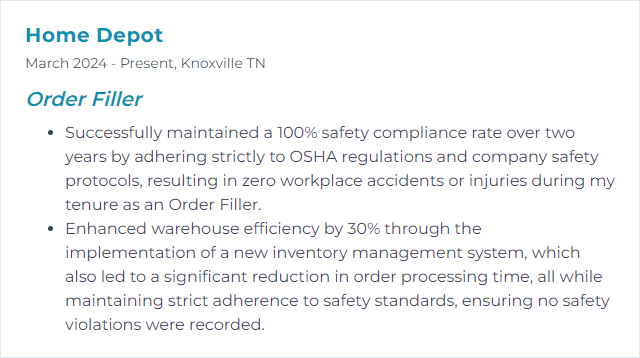
12. ERP Systems
ERP systems connect the dots—orders, inventory, purchasing, finance—so fulfillment stays aligned with the rest of the business.
Why It's Important
Real-time data and fewer manual touches mean faster turns, cleaner records, and better promise dates.
How to Improve ERP Systems Skills
- Integrate tightly: Sync ERP with WMS, scanners, and shipping tools to eliminate double entry.
- Use roles and permissions: Keep screens clean by showing only what each job needs.
- Mobile access: Let floor teams update transactions at the point of work.
- Dashboards that matter: Pick rate, order age, backorders—surface what drives action.
- Feedback and refinement: Shorten the loop between user pain and system tweaks.
How to Display ERP Systems Skills on Your Resume

